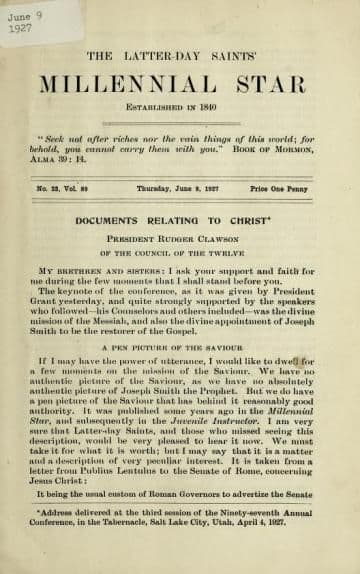Magazine
A Voice from the Dust

Title
A Voice from the Dust
Magazine
The Latter Day Saints' Millennial Star
Publication Type
Magazine Article
Year of Publication
1927
Authors
Evans, Richard L. (Primary)
Pagination
361–362
Date Published
9 June 1927
Volume
89
Issue Number
23
Abstract
This article argues that recent archaeological excavations help authenticate the Book of Mormon. Evans’ discussion includes such topics as iron, monuments, and temples.
A VOICE FROM THE DUST
Recent archaeological discoveries further substantiate the authenticity of the Book of Mormon. Excavations in Central and South America are being carried on by the “Museum of the American Indian”. An interesting article, The Pompeii of Ancient America, written by A. Hyatt Verill, appeared in the January number of the World’s Work. The following excerpts are worthy of note:
An entirely new and hitherto undreamed of culture has been revealed.
I am thoroughly convinced that these people, as well as many other prehistoric races, possessed iron or steel tools, and I do not know of a single argument or fact to disprove it. The fact that no iron or steel tools have been found proves nothing. Iron is the most perishable of metals, and except under most unusual conditions, all traces of small iron or steel tools would disappear completely in a few centuries.
The writer goes on to say that the architecture, monuments, temples, ornaments and artistic paintings have thrown light on the progressive civilization of the American aborigines. He approximates the date to be 4,000 B.C., which corresponds closely to the arrival of the Jaredites in western America, as recorded in the Book of Mormon. He also asks why the inhabitants disappeared and how it happens that no tradition or history has been found. Both tradition 'and history have been found. The Book of Mormon answers all these queries.
In 1830, when the Book of Mormon was first published, the western territory of America was an unknown wilderness, and Joseph Smith was ridiculed for stating what is now known to be truth, that a civilized people once lived upon the American Con- tin cut. Subsequent discoveries have proved him to have been a true prophet of God. There is a vast array of fact in favour of the divine authenticity of the Book of Mormon, and not a thread of evidence to the contrary. The newly found city is merely another case in point.
The greatest proof of its genuineness is contained within the record itself. Its language is inspiring, its advice is full of wisdom, its doctrine is sound, and in no instance does it contradict either the Bible or itself, but rather, each supplements and strengthens the other.
The people of the world have been warned by so-called spiritual advisers not to read the Book of Mormon. There is a vital reason for this advice. In the last chapter of the Book, Moroni 10:3-5, the following promise is given:
Behold, I would exhort you that when ye shall read these things, if it be wisdom in God that ye should read them, that ye would remember how merciful the Lord hath been unto the children of men, from the creation of Adam even down until the time that ye shall receive these things, and ponder it in your hearts.
And when ye shall receive these things, I would exhort you that ye would ask God, the Eternal Father, in the name of Christ, if these things are not true; and if ye shall ask with a sincere heart, with real intent, having faith in Christ, he will manifest the truth of it unto you, by the power of the Holy Ghost.
And by the power of the Holy Ghost ye may know the truth of all things.
These are not idle words. It is a promise from God that has been literally fulfilled whenever put to the test. Tens of thousands of honest seekers after the truth have pondered these things with a prayerful heart and a sincere intent, and have been given a testimony of the truthfulness of the work, and joyfully accepted the Gospel of Jesus Christ, restored to earth in these, the last days.
And ye shall know the truth, and the truth shall make you free. (John 8:32).
Richard L. Evans
Subject Keywords
Bibliographic Citation
Terms of use
Items in the BMC Archive are made publicly available for non-commercial, private use. Inclusion within the BMC Archive does not imply endorsement. Items do not represent the official views of The Church of Jesus Christ of Latter-day Saints or of Book of Mormon Central.